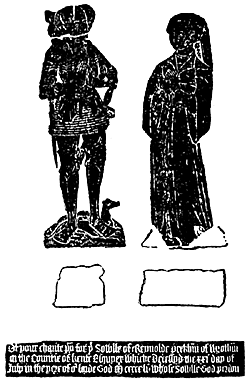The Peckham Brass at Ossington.

MR. A. E. Frost, a member of the Monumental Brass Society, who has lately come to reside in our county, has undertaken to make for that Society a complete survey and collection of rubbings of all Notts, brasses, whether mere inscriptions, or engraved figures, previous to the year 1700. In this work he has been accompanied by Mr. T. M. Blagg, and when, in the past summer, they came to examine the Peckham brass at Ossington, they discovered, from a loose fragment, that part, at least, of the brass was a palimpsest.
As the Sheffield brass at North Wheatley is the only other known palimpsest in Notts., it was desirable to make an investigation of this new discovery, and permission to take up and refix the whole brass, being obtained, Mr. Blagg applied to the Council of the Thoroton Society for funds sufficient to defray the expense. The Council readily acceded to his request.
The whole of the brass, consisting of two separate figures, three shields of arms and several inscription plates and strips (described at length on pp. 66-67 of Vol. VI. of Transactions), was carefully removed. Sets of rubbings of both obverse and reverse of each piece were made, and the whole was then refixed, opportunity being taken to place the wording of the chamfer inscription, which had become mixed, in its original order.
The rubbings were submitted by Mr. Frost to the examination of Mr. Mill Stephenson, Secretary and Editor to the Monumental Brass Society, and his report on them, is as follows :
"The whole brass, with the exception of the shield bearing the arms of Burgoyn, is palimpsest. The two principal figures are cut out of a large fourteenth century Flemish brass, apparently the figure of a lady with her gown tucked up under her arm in order to show the embroidery of an undergown or petticoat at the feet, as in the well-known examples at King's Lynn. Unfortunately, the finer work on the embroidery of the petticoat and on the edges of the undergown has been much damaged at the time of its conversion.
The foot-inscription plate is cut out of a large figure of a lady in a mantle, circa 1440, with a small dog at her feet. This is of English workmanship. Of the marginal inscription only three pieces are in good order, the rest has been filed and hammered to such an extent as to completely destroy any traces of the design with the exception of a few lines. The longest strip, inches, bearing the words "whome I my selfe shall se, and myne eyes," is cut out of a large quadrangular plate, apparently of English work, with an altar or prayer-table between two figures, but as the strip is only an inch and a half in width there is little to work upon. On the left of the altar or prayer-table, there appears a portion of a man's leg and gown, and on the right a portion of a lady's gown. Another strip, 8½ inches in length, bearing the words "shall loke upon," shows the lower corner of the altar or prayer-desk, and the bottom of the lady's robe, which is turned back as though a figure was kneeling. The third strip, 6 inches in length, bearing the words "and none oth," shows a portion of an ornamental border, possibly the edging of the large quadrangular plate.
The shield bearing the arms of Peckham quartering Burgoyne is made up of two portions of a civilian, circa 1500-20, soldered together. The larger piece shows the feet and a portion of the fur-lined gown, the smaller, the waist and portions of the sleeves. The shield bearing the arms of Peckham and Burgoyn, impaling Cranmer of Aslockton, is made up of two portions of a lady, circa 1500-20, soldered together. The larger piece shows the bottom of her gown with the terminal of the girdle, the smaller the hands and fur cuffs, and the waist encircled by the girdle, the buckle of which is very large. In all, five brasses, one Flemish and four English, appear to have been re-used to build up Peckham's monument."
